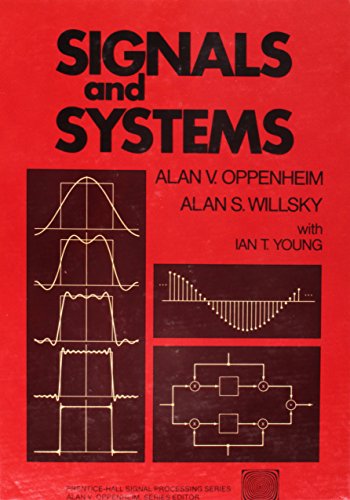
Synopsis
The present book Signals and Systems, has been written to meet the requirements of undergraduate students of all Electrical Sciences, who deal with the subject in various semesters. The order of presentation of the subject is very systematic and simplified, to make the book easy to understand.
- Unlike most books, the introduction to Signals and to Systems has been dealt with in two separate chapters, to enable the student to clearly understand the properties of the signals and properties of the systems.
- Each chapter has over 50 solved problems. The problems have been divided in various sub-headings in each chapter, and solved in various sub-sections.
- The book covers the syllabus of most Indian universities. It can also be used as an introductory textbook for Digital Signal Processing
- Matlab programs when included in each chapter, lead to confusion, especially, in UG students. Hence, a separate chapter has been included on Matlab.
"synopsis" may belong to another edition of this title.
From the Back Cover
This comprehensive exploration of signals and systems develops continuous- time and discrete-time concepts/methods in parallel — highlighting the similarities and differences — and features introductory treatments of the applications of these basic methods in such areas as filtering, communication, sampling, discrete-time processing of continuous-time signals, and feedback. Relatively self-contained, the book assumes no prior experience with system analysis, convolution, Fourier analysis, or Laplace and z-transforms.
FEATURES:
- Develops continuous-time and discrete-time concepts in parallel — highlighting the similarities and differences. E.g.:
- Ch. 1 on basic signals and system properties, Ch. 2 on linear time-invariant systems, and Ch. 3 on Fourier series representation each develop the continuous-time and discrete-time concepts in parallel.
- Ch. 9 on the Laplace Transform and Ch. 10 on the Z-transform deal with the two domains separately, but often draw parallels between results in the two domains.
- Introduces some of the important uses of the basic methods that are developed — e.g., filtering, communication, sampling, discrete-time processing of continuous-time signals, and feedback.
- NEW—Material on Fourier analysis has been reorganized significantly to provide an easier path for the reader to master and appreciate the importance of this topic. Now represented in four chapters, each of which is far more streamlined and focused, introducing a smaller and more cohesive set of topics.
- NEW—Frequency-domain filtering is introduced very early in the development to provide a central and concrete illustration of why this topic is important and to provide some intuition with a minimal amount of mathematical preliminaries.
- NEW—Relocates coverage of Sampling before Communication. * Allows for discussion of important forms of communication, namely those involving discrete or digital signals, in which sampling concepts are intimately involved.
- NEW—Chapter-end Problems
- They provide a better balance between exercises developing basic skills and understanding ones that pursue more advanced problem-solving skills. The new edition organizes chapter-end problems into four types of sections which makes it easier for the reader to locate the problems that will best serve their purposes; and provides two types of basic problems, ones with answers (but not solutions); and ones with solutions to provide immediate feedback, while attempting to master the material.
The four types of chapter-end problems are—- Basic Problems with Answers.
- Basic Problems.
- Advanced Problems.
- Extension Problems.
Synopsis
This exploration of signals and systems develops continuous-time and discrete-time concepts/methods in parallel, and features introductory treatments of the applications of these basic methods in such areas as filtering, communication, sampling, discrete-time processing of continuous-time signals, and feedback.
"About this title" may belong to another edition of this title.
Other Popular Editions of the Same Title
Search results for Signals and Systems (Prentice-Hall signal processing...
Signals and Systems (Prentice-Hall signal processing series)
Seller: -OnTimeBooks-, Phoenix, AZ, U.S.A.
Condition: good. A copy that has been read, remains in good condition. All pages are intact, and the cover is intact. The spine and cover show signs of wear. Pages can include notes and highlighting and show signs of wear, and the copy can include "From the library of" labels or previous owner inscriptions. 100% GUARANTEE! Shipped with delivery confirmation, if you're not satisfied with purchase please return item for full refund. Ships via media mail. Seller Inventory # OTV.0138097313.G
Signals and Systems (Prentice-Hall signal processing series)
Seller: HPB-Red, Dallas, TX, U.S.A.
Hardcover. Condition: Acceptable. Connecting readers with great books since 1972. Used textbooks may not include companion materials such as access codes, etc. May have condition issues including wear and notes/highlighting. We ship orders daily and Customer Service is our top priority! Seller Inventory # S_443137939
Signals and Systems (Prentice-Hall signal processing series)
Seller: HPB-Red, Dallas, TX, U.S.A.
Hardcover. Condition: Good. Connecting readers with great books since 1972! Used textbooks may not include companion materials such as access codes, etc. May have some wear or writing/highlighting. We ship orders daily and Customer Service is our top priority! Seller Inventory # S_449953302
Signals and Systems (Prentice-Hall signal processing series)
Seller: Jenson Books Inc, Logan, UT, U.S.A.
hardcover. Condition: Good. The item is in good condition and works perfectly, however it is showing some signs of previous ownership which could include: small tears, scuffing, notes, highlighting, gift inscriptions, and library markings. Seller Inventory # 4BQWN8005LD9
Signals and Systems (Prentice-Hall signal processing series)
Seller: The Book Spot, Sioux Falls, MN, U.S.A.
Hardcover. Condition: New. Seller Inventory # Abebooks63322
Signals and Systems PrenticeHa
Seller: World of Books (was SecondSale), Montgomery, IL, U.S.A.
Condition: Very Good. Item in very good condition! Textbooks may not include supplemental items i.e. CDs, access codes etc. Seller Inventory # 00093935845
Signals and Systems (Prentice-Hall signal processing series)
Seller: Toscana Books, AUSTIN, TX, U.S.A.
Hardcover. Condition: new. Excellent Condition.Excels in customer satisfaction, prompt replies, and quality checks. Seller Inventory # Scanned0138097313

